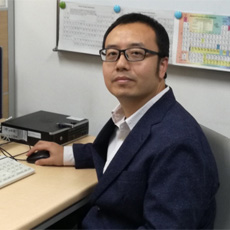Researcher Introduction
Elements Strategy Initiative for Structural Materials, Kyoto University Specially Appointed Assistant Professor
Junping Du
Motivation for Becoming a Researcher
I first came into contact with molecular dynamics simulations on the atomic scale as an undergraduate student, and I was fascinated at how the prescribed interatomic potential (force) used in molecular dynamics fully controls the mechanical response of the materials. Curiosity in how the interatomic potentials are constructed and how they affect simulation results of the mechanical properties of materials motivates me to become a researcher.
Your Greatest Strengths
I am good at constructing embedded-atom-method potentials for multi-element metal systems and using accelerated molecular dynamics to accelerate the occurrence of rare events, such as dislocation nucleation in metals.
What Makes Your Research Interesting or Worthwhile
Molecular dynamics (MD) simulation has been widely used in the study of the material properties. Two bottlenecks in the application of the MD method are the lack of multi-element potentials and the time-scale limitation. My research is centered on these two topics.
Other Research That Interests You
I would like to continue my work on constructing multi-element interatomic potentials in the future in order to study the relationship between constituent elements and the strength of structural materials using the molecular dynamics method.
Interests Other Than Research You Would Like to Pursue
I like to exercise after work, e.g. jogging and mountain climbing, and to spend quality time with my family.

Junping Du
Elements Strategy Initiative for Structural Materials, Kyoto University Specially Appointed Assistant Professor
Principal Work History:
I obtained a Ph.D. in Materials Physics and Chemistry at the Central Iron and Steel Research Institute, China, in 2014. The topic of my thesis was “Construction and application of multi-element EAM potential in Ni-based single crystal model superalloys.” From April 2014 to March 2016, I worked as a specially appointed researcher in Prof. Shigenobu Ogata’s group at Osaka University. Since April 2016, I have remained as visiting researcher in Prof. Shigenobu Ogata’s group. From April 2016 to November 2016, I worked for the Elements Strategy Initiative for Structural Materials (ESISM) at Kyoto University as a specially appointed researcher, and since November 2016 as a specially appointed assistant professor.
Notable Articles:
- [1] Jun-Ping Du, Yun-Jiang Wang, Yu-Chieh Lo, Liang Wan, and Shigenobu Ogata. “Mechanism transition and strong temperature dependence of dislocation nucleation from grain boundaries: An accelerated molecular dynamics study.” Physical Review B, Vol. 94 (2016): 104110 (8 pp.).
- [2] Jun-Ping Du, Chong-Yu Wang and Tao Yu. “Construction and application of multi-element EAM potential (Ni-Al-Re) in γ/γ´ Ni-based single crystal superalloys.” Modelling Simulation in Materials Science and Engineering, Vol. 21 (2013): 015007 (27 pp.).
E-mail Address
jpdu(at)tsme.me.es.osaka-u.ac.jp
*Please change the (at) to @.